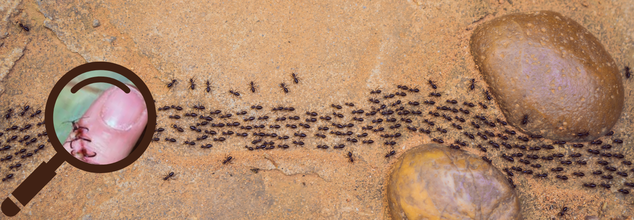- Health Conditions A-Z
- Health & Wellness
- Nutrition
- Fitness
- Health News
- Ayurveda
- Videos
- Medicine A-Z
- Parenting
- Web Stories
Can Wild Ants Perform Surgeries?

Once in a while, you must have come across weird or unusual home remedies that actually work. But have you ever heard of ants who can perform surgeries? Scientists have found and recorded proof of surgical ants. There are two kinds: one set that performs surgery among its siblings in the colony, and the other set is used by humans as sutures.
The Surgical Ants
A July 2024 University of Lausanne study found that carpenter ants carry out lifesaving amputations on their colony siblings. This is also the first case of a non-human animal amputating limbs that stops the infection from spreading.
The researchers found that the bites made in ants' bodies by other ants were not random, but well thought and had a survival rate of over 90%. The three ants in the experiment who did not have their legs amputated died.
Most ants also have salivary secretions with antimicrobial properties, which help to control bacterial infection when they lick wounds. Carpenter ants therefore use both, the surgical incision and their salivary glands to prevent the infection from spreading in amputated limbs.
The study found that the ants alter the treatment as per the need of the injury. The experiment found that when the femur was damaged, the ants amputated near the body and removed the whole leg. The upper part of the leg contains a muscle mass that can lead to microbial infection. This is why a high amputation means that the patient will more likely survive.
Ants treat damaged tibiae, which is a condition that may lead to a low post-amputation survival rate. It is treated by licking. This removes the dirt from the wound and cleans the wound up to prevent infection.
Ants As Sutures
In ancient India, and in parts of Africa, and South America, this method was used to stitch open wounds. When people went to the battlefield with limited medical resources, they used wild ants as sutures.
In India, the weaver ant (Oecophylla smaragdina) was used for the same. The wounded person would the edges of the wound together and allow the ant to bite across the cut. As the ant's mandibles were firmly clamped onto the skin, the body was removed and the head was kept in the same place to hold the wound closed.
In parts of Africa, the Dorylus or driver ant, known for its strong jaws was used by indigenous tribes. They clamped down on the wound tightly, and the heads remained attached, acting as natural sutures.
Similarly, in South American regions too, people used ants to treat wounds, where their bodies were removed and heads were used as suture.
It was also safe because ants are not carriers of any infection or bacteria, rather their saliva works as antimicrobial.
India Health Summit 2025 | How Can India Become Mentally Fit And Healthy?

The Ministry of Health & Family Welfare noted India contributes to 18% of the global population, and as per the World Health Organization (WHO), the burden of mental health problems in India is 2433 disability-adjusted life years (DALYs) per 10000 population. The age-adjusted suicide rate is per 21.1 per 100000 population, and the economic loss between 2012-2030 is estimated at USD 1.03 trillion.
Another study published in 2024 in Cureus, quotes a previous study from early 2021 by UNICEF and Gallup that reveals that children in India were hesitant seeking help for mental health.
According to another 2024 study, the prevalence rate of mental health issues in children and teenagers in India was determined to be 23.33% in school and 6.46% in the community. The National Mental Health Survey 2016 also found that teenagers had a 7.3% prevalence of illness, distributed equally across boys and girls. However, it was greater in metropolitan metro areas, and the prevalence of anxiety issues was 3.6%, with depression-related conditions at 0.8%
What Is India Doing To Tackle The Mental Health Problem?
While the challenges remain, the government has taken several initiatives to tackle mental health issues. It was especially during the COVID-19 pandemic, when mental health problems rose in India, as a result the government set up a 24/7 helpline to provide psychosocial support, by mental health professionals, to the entire affected population, divided into different target groups viz children, adult, elderly, women and healthcare workers. Till date a total of 5,77,743 calls have been received on the helpline.
Furthermore, as part of the National Mental Health Programme, in 2024, 25 Centres of Excellence were sanctioned set up to train more postgraduate students in mental health and provide advanced treatment. 47 postgraduate departments in mental health were also established or upgraded in 19 government colleges. Mental health services were also introduced in 22 newly established AIIMS.
Read: India Health Summit 2025 | How India Is Bringing Innovation And Accessibility To Advance Cancer Care
Why Is India's Youth Struggling?
A 2025 study published in the International Journal of Indian Psychology notes certain risk factors due to which the Indian youth is struggling with mental health issues:
Family Environment and Parenting Style: Dysfunctional family dynamics lead to poor mental health outcomes in Indian youth
Substance Use and Peer Influence: Interaction with antisocial peers can lead to substance abuse and further lead to depression
Academic Pressure and Performance Anxiety: There is intense pressure to perform in academics, and the parental expectation that leads to risk of depression in youth
Socioeconomic Status: Youth from financially disadvantaged families face higher risks of depression and anxiety due to income struggles and financial stress
Violence, Abuse, and Trauma: Exposure to physical or sexual abuse significantly increases the likelihood of depression and anxiety in young people
Gender, Identity, and Relationship Issues: Struggles with gender, sexuality, or relationships heighten vulnerability to mental health crises, often worsened by stigma and isolation
Urban vs. Rural Settings: Urban youth report more mental health disorders than rural youth, linked to academic pressure, social isolation, and weaker family support
Pandemic-Related Stress: The COVID-19 pandemic intensified depressive symptoms among students, with women disproportionately affected due to added household burdens and limited social interaction.
What More Can Be Done To Make Indian Youth Mentally Fit And Healthier?
While there have been initiatives by the government to make mental health more accessible, there still exists a gap between the ratio of mental health experts and those who need it. Furthermore, there is a huge gap of accessibility between rural and urban areas. To understand how can one solve this, the upcoming Times Now Health Summit is hosting a session on Youth and Mental Health: Coping in the Age of Pressure and making India Fitter and Healthier. The session will feature experts from across various fields, including healthcare experts and mental health advocates.
The panel will feature Mayank Srivastava(IPS), Deputy Director General, Major Gen(Retd.) Vikram Dev Dogra, Dr. Praveen Gupta, Chairman, Marengo Asia International Institute of Neuro & Spine (MAIINS), Gurugram, and actress Pooja Bedi.
For more details, visit TIMES NETWORK INDIA HEALTH SUMMIT 2025.
Why Is This Doctor Asking President Trump To Take Alzheimer's Test?

Credits: AP and Neuropsychologysources
After two psychologists raised questions about the US President Donald Trump's mental health, saying that he showed signs of frontotemporal dementia (FTD), questions about his cognitive health is again intensified after Dr Narinder Kapur, a consultant neuropsychologist and visiting professor at the University College London said that president's behavior over the last six months has been "quite odd and strange," as reported by Express, UK.
Kapur said that Trump's suggestion that Canada should become the 51st US state. and his desire to "take over Greenland", and his controversial comments linking autism with paracetamol are really "bizarre". “Even though he’s probably been led a bit by [Robert F.] Kennedy [Jr.] on that, still for Trump to say the things he did was really quite odd and bizarre,” he said.
While Kapur did not diagnose Trump with dementia, he did suggest the possibility of frontotemporal dementia. “If one was thinking about the various possible dementias he’s got, certainly frontotemporal dementia is one of them, because some of his behavior has been really quite bizarre,” he said, adding that an Alzheimer’s test would help clarify concerns.
Is Trump Really Mentally Fit?
Trump, 79, has dismissed doubt about his mental fitness and calling himself the "stable genius". However, a report by the Guardian highlights growing number of unusual public appearances of Trump, which may suggest otherwise.
On his July trip to the UK, Trump unexpectedly veered into a monologue about windmills while meeting European Commission president Ursula von der Leyen. For two minutes, he claimed without evidence that wind turbines were driving whales “loco” and destroying scenery. “The abrupt changes in conversation are an example of Trump digressing without thinking, he’ll just switch topics without self-regulation,” Harry Segal, senior lecturer in psychology at Cornell University, told The Guardian.
Another instance is from a cabinet meeting intended to discuss global crises, Trump instead spoke for over 13 minutes about lamps, frames, and the color of paint used in the cabinet room.
What Are The Experts Saying?
Experts have pointed out that Trump's apparent tendency toward confabulation, which refers to confidently recounting events that never happened. The Guardian reported that Trump recently claimed his late uncle professor John Trump had taught Ted Kaczynski, the Unabomber, at MIT. The timeline makes this impossible: John Trump died in 1985, more than a decade before Kaczynski was publicly identified, and Kaczynski never studied at MIT.
Richard A. Friedman, professor of clinical psychiatry at Weill Cornell Medicine, told The Atlantic after one such performance: “If a patient presented to me with the verbal incoherence, tangential thinking, and repetitive speech that Trump now regularly demonstrates, I would almost certainly refer them for a rigorous neuropsychiatric evaluation to rule out a cognitive illness.”
Psychologist Dr. John Gartner, formerly of Johns Hopkins University, has tracked what he describes as a “major deterioration” in Trump’s language skills, motor skills, and impulse control. “If you go back and look at film from the 1980s, [Trump] actually was extremely articulate… now he really has trouble completing a thought and that is a huge deterioration,” Gartner told The Guardian.
He warned that Trump’s decline may accelerate: “At the rate he is deteriorating, it’s going to get worse. That’s my prediction.”
How Second-Hand Smoke Impacts Children’s Health, New Study Reveals Alarming Effects

Credits: Canva
Children around the world lose an estimated 8.45 million days of healthy life each year due to second-hand smoke, according to research shared at the European Respiratory Society Congress in Amsterdam. The impact is especially severe for children from low-income communities, who are more likely to encounter smoke at home, in public areas, or in indoor spaces, even though they themselves do not smoke.
Second-Hand Smoke’s Toll on ChildrenRecent studies confirm that second-hand smoke (SHS, which is also known as passive smoking, is a major factor in childhood illness and mortality, contributing to both deaths and long-term disabilities. Research published in Respiratory Research (2025) highlights the global scale of the problem, telling which populations are most affected and the conditions that maintain or increase exposure. The findings suggest that the health burden may be even higher than previously estimated, emphasizing the need for stronger protections.
What the Data ShowsThe Global Burden of Diseases 2021 analysis reports that while age-standardized exposure to SHS has slightly declined since 1990, the absolute number of deaths and lost healthy life years has not fallen, largely due to population growth and aging. Around half of all children worldwide are still exposed to smoke, with the heaviest burden falling on regions with lower socio-economic development. Many low- and middle-income countries have yet to implement comprehensive smoke-free policies in indoor environments.
Passive Smoking Impact on Young Children
Second-hand smoke contributes significantly to respiratory illnesses. In 2019, roughly 6.94% of deaths from lower respiratory infections in children under five were linked to SHS exposure, with infants under one year at particular risk. The loss of healthy life years remains high, and trends show slow improvement in regions such as South Asia.
Beyond respiratory issues, SHS exposure is linked to stunted growth, ear infections, and long-term lung problems. According to WHO data, nearly 150 million children worldwide were stunted in 2022, and second-hand smoke, both during pregnancy and after birth, is a contributing factor. Studies also show that SHS can cause changes in DNA methylation, potentially altering gene expression and increasing susceptibility to future disease.
Challenges in Protecting Children
Homes remain the primary setting for exposure, even as public smoking bans expand. Social and economic factors—such as crowded living conditions, poor ventilation, lower awareness of risks, and weaker regulatory enforcement—further increase children’s vulnerability.
Precaution Steps That You Can Adopt
Experts recommend several strategies to reduce children’s exposure to second-hand smoke:- Create and enforce completely smoke-free indoor spaces, including homes and vehicles.
- Increase awareness among caregivers and the public, emphasizing the dangers of indoor smoking.
- Simple measures, like smoking outdoors away from doors and windows, can make a difference.
- Pregnant women should avoid SHS entirely, as exposure in utero can lead to low birth weight and preterm births.
- Health systems should track SHS exposure in children through routine check-ups and surveys.
Second-hand smoke is far from a minor concern. It remains a threat to child health, causing preventable illness, developmental setbacks, and death. Protecting children requires a combination of effective policies, public awareness, and everyday actions by parents, caregivers, and communities. Even small steps, like choosing smoke-free homes and outdoor smoking can significantly reduce risks.
© 2024 Bennett, Coleman & Company Limited

